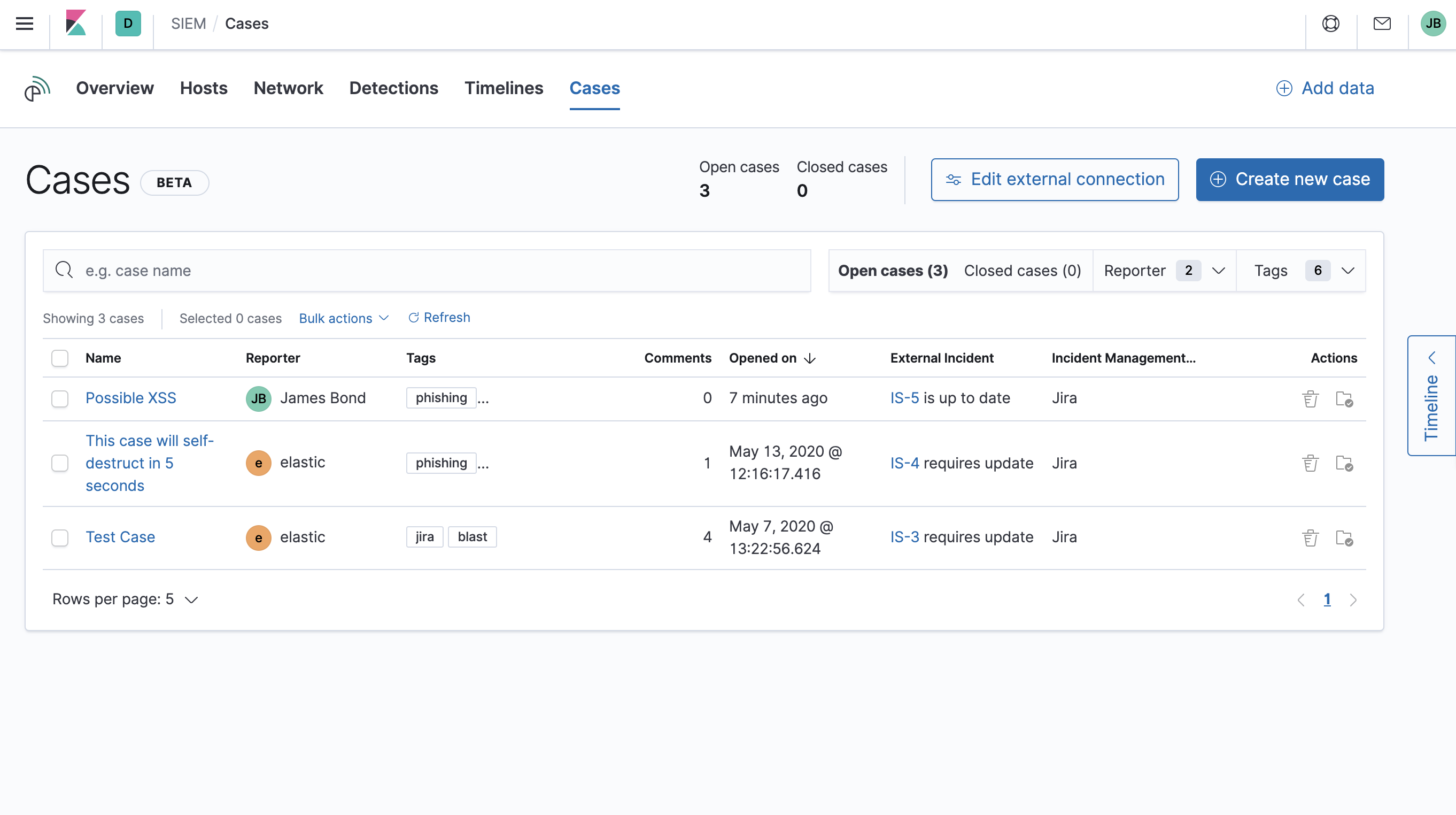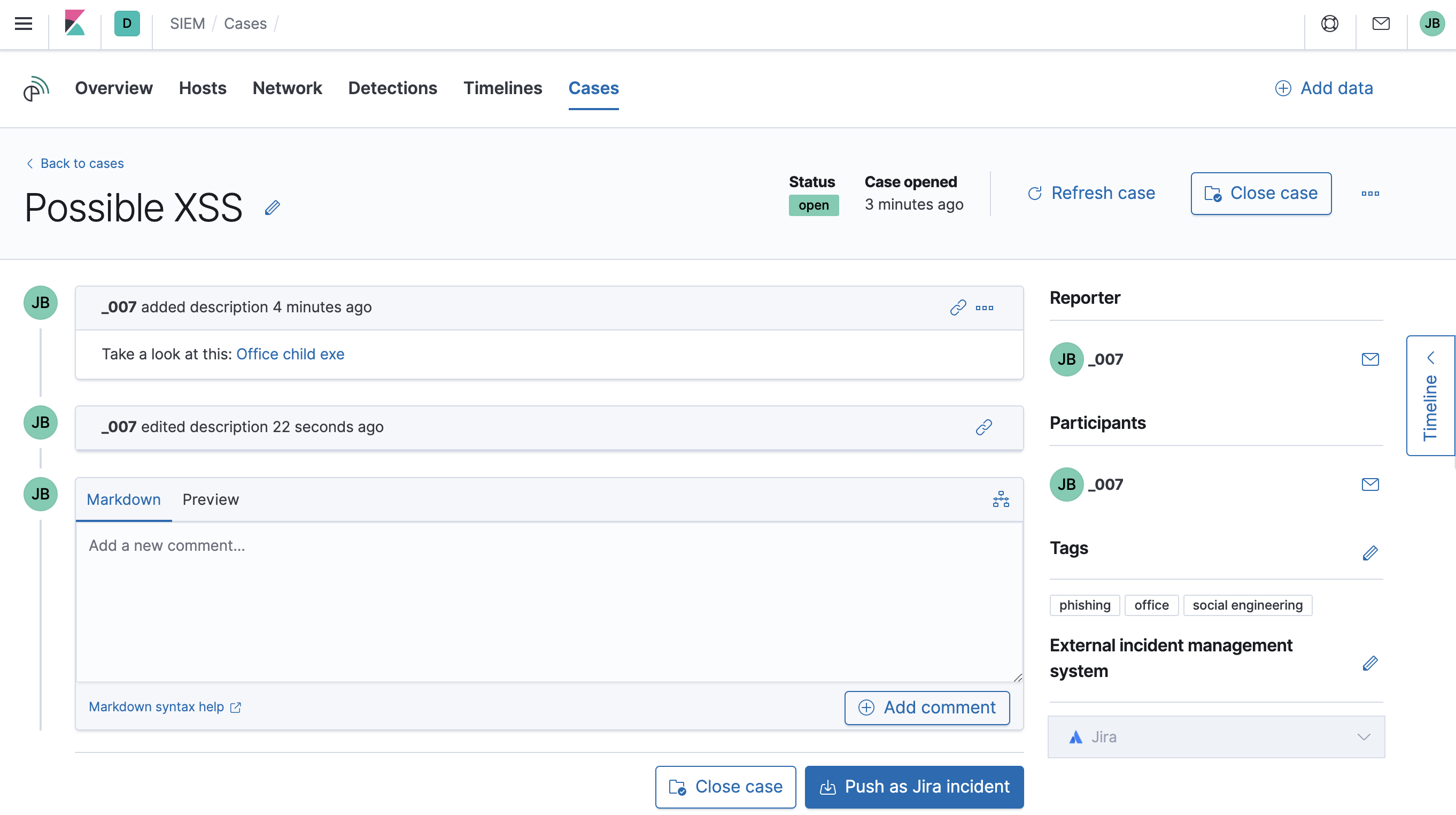- SIEM Guide:
- Overview
- Get up and running
- SIEM UI
- Anomaly Detection with Machine Learning
- Detections (beta)
- Managing signal detection rules
- Prebuilt rule reference
- Adding Hidden File Attribute via Attrib
- Adobe Hijack Persistence
- Adversary Behavior - Detected - Elastic Endpoint
- Anomalous Process For a Linux Population
- Anomalous Process For a Windows Population
- Anomalous Windows Process Creation
- Attempt to Disable IPTables or Firewall
- Attempt to Disable Syslog Service
- Base16 or Base32 Encoding/Decoding Activity
- Base64 Encoding/Decoding Activity
- Bypass UAC via Event Viewer
- Clearing Windows Event Logs
- Command Prompt Network Connection
- Connection to External Network via Telnet
- Connection to Internal Network via Telnet
- Credential Dumping - Detected - Elastic Endpoint
- Credential Dumping - Prevented - Elastic Endpoint
- Credential Manipulation - Detected - Elastic Endpoint
- Credential Manipulation - Prevented - Elastic Endpoint
- DNS Activity to the Internet
- DNS Tunneling
- Delete Volume USN Journal with Fsutil
- Deleting Backup Catalogs with Wbadmin
- Direct Outbound SMB Connection
- Disable Windows Firewall Rules via Netsh
- Encoding or Decoding Files via CertUtil
- Enumeration of Kernel Modules
- Execution via Regsvcs/Regasm
- Exploit - Detected - Elastic Endpoint
- Exploit - Prevented - Elastic Endpoint
- FTP (File Transfer Protocol) Activity to the Internet
- File Deletion via Shred
- File Permission Modification in Writable Directory
- Hex Encoding/Decoding Activity
- Hping Process Activity
- IPSEC NAT Traversal Port Activity
- IRC (Internet Relay Chat) Protocol Activity to the Internet
- Interactive Terminal Spawned via Perl
- Interactive Terminal Spawned via Python
- Kernel Module Removal
- Local Scheduled Task Commands
- Local Service Commands
- Malware - Detected - Elastic Endpoint
- Malware - Prevented - Elastic Endpoint
- Microsoft Build Engine Loading Windows Credential Libraries
- Microsoft Build Engine Started an Unusual Process
- Microsoft Build Engine Started by a Script Process
- Microsoft Build Engine Started by a System Process
- Microsoft Build Engine Started by an Office Application
- Microsoft Build Engine Using an Alternate Name
- Mknod Process Activity
- Modification of Boot Configuration
- MsBuild Making Network Connections
- Net command via SYSTEM account
- Netcat Network Activity
- Network Connection via Certutil
- Network Connection via Compiled HTML File
- Network Connection via MsXsl
- Network Connection via Mshta
- Network Connection via Regsvr
- Network Connection via Signed Binary
- Network Sniffing via Tcpdump
- Nmap Process Activity
- Nping Process Activity
- PPTP (Point to Point Tunneling Protocol) Activity
- Permission Theft - Detected - Elastic Endpoint
- Permission Theft - Prevented - Elastic Endpoint
- Persistence via Kernel Module Modification
- Potential Application Shimming via Sdbinst
- Potential DNS Tunneling via Iodine
- Potential Disabling of SELinux
- Potential Evasion via Filter Manager
- Potential Modification of Accessibility Binaries
- Potential Shell via Web Server
- PowerShell spawning Cmd
- Process Activity via Compiled HTML File
- Process Discovery via Tasklist
- Process Injection - Detected - Elastic Endpoint
- Process Injection - Prevented - Elastic Endpoint
- Process Injection by the Microsoft Build Engine
- Proxy Port Activity to the Internet
- PsExec Network Connection
- RDP (Remote Desktop Protocol) from the Internet
- RDP (Remote Desktop Protocol) to the Internet
- RPC (Remote Procedure Call) from the Internet
- RPC (Remote Procedure Call) to the Internet
- Ransomware - Detected - Elastic Endpoint
- Ransomware - Prevented - Elastic Endpoint
- SMB (Windows File Sharing) Activity to the Internet
- SMTP on Port 26/TCP
- SMTP to the Internet
- SQL Traffic to the Internet
- SSH (Secure Shell) from the Internet
- SSH (Secure Shell) to the Internet
- Setgid Bit Set via chmod
- Setuid Bit Set via chmod
- Socat Process Activity
- Strace Process Activity
- Sudoers File Modification
- Suspicious MS Office Child Process
- Suspicious MS Outlook Child Process
- Suspicious PDF Reader Child Process
- Suspicious Powershell Script
- Svchost spawning Cmd
- System Shells via Services
- TCP Port 8000 Activity to the Internet
- Telnet Port Activity
- Tor Activity to the Internet
- Trusted Developer Application Usage
- Unusual DNS Activity
- Unusual Linux Network Activity
- Unusual Linux Network Port Activity
- Unusual Linux Network Service
- Unusual Linux Username
- Unusual Linux Web Activity
- Unusual Login Activity
- Unusual Network Connection via RunDLL32
- Unusual Network Destination Domain Name
- Unusual Parent-Child Relationship
- Unusual Process Execution - Temp
- Unusual Process For a Linux Host
- Unusual Process For a Windows Host
- Unusual Process Network Connection
- Unusual Web Request
- Unusual Web User Agent
- Unusual Windows Network Activity
- Unusual Windows Path Activity
- Unusual Windows Remote User
- Unusual Windows Service
- Unusual Windows User Privilege Elevation Activity
- Unusual Windows Username
- User Account Creation
- User Discovery via Whoami
- VNC (Virtual Network Computing) from the Internet
- VNC (Virtual Network Computing) to the Internet
- Virtual Machine Fingerprinting
- Volume Shadow Copy Deletion via VssAdmin
- Volume Shadow Copy Deletion via WMIC
- Web Application Suspicious Activity: No User Agent
- Web Application Suspicious Activity: POST Request Declined
- Web Application Suspicious Activity: Unauthorized Method
- Web Application Suspicious Activity: sqlmap User Agent
- Whoami Process Activity
- Windows CryptoAPI Spoofing Vulnerability (CVE-2020-0601 - CurveBall)
- Windows Script Executing PowerShell
- Tuning prebuilt detection rules
- Prebuilt rule changes per release
- Cases (beta)
- SIEM APIs
- Detections API
- Cases API
- Create case
- Add comment
- Update case
- Update comment
- Find cases
- Get case
- Get all case comments
- Get comment
- Get all case activity
- Get tags
- Get reporters
- Get status
- Delete comment
- Delete all comments
- Delete case
- Set default SIEM UI connector
- Update case configurations
- Get current connector
- Find connectors
- Add external details to case
- Actions API (for pushing cases to external systems)
- SIEM field reference guide
IMPORTANT: No additional bug fixes or documentation updates will be released for this version.
Cases (beta)
editCases (beta)
editThis functionality is in beta and is subject to change. The design and code is less mature than official GA features and is being provided as-is with no warranties. Beta features are not subject to the support SLA of official GA features.
Cases are used to open and track security issues directly in the SIEM app.
All cases list the original reporter and all users who contribute to a case
(participants). Comments support Markdown syntax, and allow linking to saved
Timelines. Additionally, you can send cases to external
systems from within the SIEM app (currently ServiceNow and Jira).
Configuring external connections describes how to set this up.
You can create and manage cases via the UI or the Cases API.
To send cases to external systems, you need the appropriate license.
To make sure you can view and open cases, see Cases prerequisites.

Open a new case
editOpen a new case to keep track of security issues and share their details with colleagues.
- Go to SIEM → Cases → Create new case.
-
Give the case a name, and add a description and any relevant tags.
In the
Descriptionarea, you can use Markdown syntax and insert a timeline link (click the icon in the top right corner of the area). - When ready, create the case.
-
If external connections are configured, you can:
-
Select which connector is used to send the case to an external system
(
External incident management system). - Send the case to an external system. You can send the case to more than one external system.
-
Select which connector is used to send the case to an external system
(

Manage existing cases
editYou can search existing cases, and filter them by tags, reporter, and status (open or closed).
To view a case, click on its name. You can then:
- Add a new comment.
- Edit existing comments and the case’s description.
- Send updates to external systems (if external connections are configured).
- Close the case.
- Reopen a closed case.
- Edit tags.
- Refresh the case to retrieve the latest updates.
Comments can also contain Markdown syntax and timeline links.
Cases prerequisites
editTo view cases, you need the Kibana space Read privilege for the Saved Objects
Management feature. To create cases and add comments, you need the All Kibana
space privilege for the Saved Objects Management feature. For more information,
see Feature access based on user privileges.